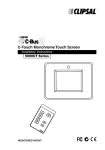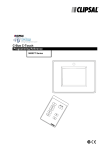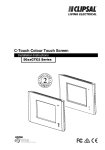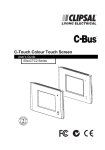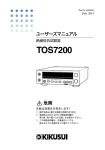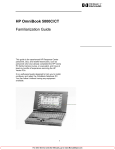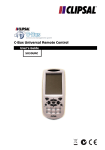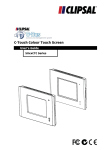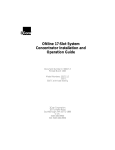Download Clipsal 5000CT Series User`s guide
Transcript
C-Bus C-Touch User’s Guide 5 0 0 0 C T Series C-Touch Monochrome Touch Screen User's Guide 5000CT Series REGISTERED PATENT Intelligent Building Series C-Touch User’s Guide Table of Contents Section ....................................................................................................................Page 1.0 2.0 3.0 4.0 5.0 5.1 5.1.1 5.1.2 5.1.3 6.0 7.0 7.1 7.1.1 7.1.2 7.1.3 7.1.4 7.2 7.2.1 7.2.2 7.2.3 7.2.4 8.0 8.1 8.2 8.3 8.3.1 8.3.2 9.0 10.0 11.0 12.0 13.0 14.0 15.0 16.0 17.0 Product Range................................................................................................. 3 Description....................................................................................................... 3 Capabilities.......................................................................................................4 Definitions.........................................................................................................4 Getting Started.................................................................................................6 Buttons............................................................................................................. 6 Control Buttons.................................................................................................7 Navigation Buttons........................................................................................... 7 Sliders.............................................................................................................. 8 Example Touch Screen Configuration.............................................................. 9 Utility and Setting Pages.................................................................................10 Utility Pages....................................................................................................10 Diagnostics Pages..........................................................................................10 Calibration Page.............................................................................................10 Startup Page...................................................................................................10 Cleaning Page................................................................................................11 Setting Pages.................................................................................................11 Time Setting Page..........................................................................................11 Date Setting Page...........................................................................................12 Contrast Adjustment Page..............................................................................13 Backlight Control Page...................................................................................14 New Features in Firmware 1.8........................................................................15 Scene Editing..................................................................................................15 Schedule Editing.............................................................................................16 New Pages......................................................................................................18 Diagnostics Page............................................................................................18 Backlight Page................................................................................................18 Passwords.......................................................................................................19 Remote Control...............................................................................................20 Scenes........................................................................................................... 21 Schedules...................................................................................................... 21 Care Instructions............................................................................................ 21 Power Failure..................................................................................................21 Product Specifications....................................................................................22 Limited Warranty.............................................................................................23 Installer Details...............................................................................................24 Copyright Notice © Copyright 2003 Clipsal Integrated Systems Pty Ltd. All rights reserved. Trademarks Clipsal is a registered trademark of Gerard Industries Pty Ltd. C-Bus and C-Bus2 are a registered trademark of Clipsal Integrated Systems Pty Ltd. Scene Master is a registered trademark of Clipsal Integrated Systems Pty Ltd. Intelligent Building Series is a registered trademark of Clipsal Integrated Systems Pty Ltd. All other logos and trademarks are the property of their respective owners. Disclaimer Clipsal Integrated Systems Pty Ltd reserves the right to change specifications or designs described in this manual without notice and without obligation. © Copyright 2003 Clipsal Integrated Systems Pty Ltd. Page 2 Intelligent Building Series 1.0 C-Touch User’s Guide Product Range SC5000CT C-Touch, slim line style (includes one 5035TX) BS5000CT C-Touch, stainless steel (includes one 5035TX) BB5000CT C-Touch, brass (includes one 5035TX) 5035TX C-Touch (or Scene Master) hand held infrared remote control. 5050CTS Neo-style Surround (Accessory Item) 2.0 Description The C-Touch unit is a flexible and powerful controller and scheduler for C-Bus systems which has infrared remote control capabilities. C-Touch is a touch screen with a backlit black and white liquid crystal (LCD) display, which can be mounted in the wall of your home or building and can be connected to the C-Bus home automation system. It can provide a central point of control and scheduling of services throughout the home. The C-Touch unit can display a series of “pages” which contain touch sensitive controls associated with various loads throughout the C-Bus Network. These pages may be re-configured by means of a personal computer running the C-Touch configuration software. Through the C-Touch unit the user may set up “scenes” with multiple loads coming on together to set a particular mood at the press of a soft button. The C-Touch unit can also control loads according to a schedule. The appearance of every C-Touch setup will be unique, so your C-Touch display may not look like the examples in this guide. © Copyright 2003 Clipsal Integrated Systems Pty Ltd. Page 3 Intelligent Building Series 3.0 C-Touch User’s Guide Capabilities The C-Touch unit can provide the following functions: • Switching of loads • Dimming • User presets • User timers • Inbuilt self-diagnostic utility • Page based display of information from a C-Bus Network • Pages can contain drawings, pictures and text in multiple languages • Control of up to 100 different loads in different areas • Provision of Scenes to control multiple loads • Provision of Scheduling, loads can be turned on or off on a regular basis • Variable fade rates for each load or lighting zone • Infrared remote control • Backlit display for ease of use in low light situations • User-friendly naming of controls • Display of time and date • Adjustable confirmation beep • Adjustable backlight control 4.0 Definitions The following definitions are useful in discussing the C-Touch unit: Term Definition Load A load is an electrical device connected to mains voltage via a C-Bus Output Unit. Most loads are lights, but may be any device such as sprinklers, AC Power points, heaters, projection screens, motors etc. Group Address This is the C-Bus designation for an output channel. It could represent one or more loads. Scene A scene is defined as a combination of loads distributed in various control zones with different levels. The scene can be set up with the configuration software and assigned to soft keys on the C-Touch unit. Fade Rate The fade rate indicates the length of time it takes for a load to ramp to a desired level. Zone Refers to an illuminated area. In C-Touch a zone is a C-Bus Group address representing one or many loads connected to a C-Bus output unit. All the lights in your dining room might be in one zone. Schedule A schedule is a sequence of events that are to occur at particular times or dates in the future. Soft Key An area on the surface of C-Touch which can be pressed to cause something to happen. © Copyright 2003 Clipsal Integrated Systems Pty Ltd. Page 4 Intelligent Building Series C-Touch User’s Guide Term Definition Page A page is an assortment of soft keys and graphics that represents something understandable to the user. Component A graphical object displayed on a C-Touch screen. Components include soft keys, images, text, clocks, temperature sensors and other items. Backlight The back of the screen is illuminated to make it visible when it is dark. This illumination is called backlight. Input Unit An input unit is a C-Bus unit which the user interacts with to make things happen on a C-Bus Network (C-Touch itself, a key input unit or passive infrared sensor are examples) Output Unit An output unit delivers power to loads; a relay and dimmer are examples. Control A component that can be used to turn loads on or off or change their level. Pictorial View of Touch Screen NOTE: Remove protective film prior to fitting cover. © Copyright 2003 Clipsal Integrated Systems Pty Ltd. Page 5 Intelligent Building Series 5.0 C-Touch User’s Guide Getting Started The C-Touch unit can display pages with many different kinds of Components. Components that you may use include: • • • • Clocks with date and/or time Percentage indicators Images Text These components may just be graphic design elements or could actually perform some useful action when pressed. The layout and configuration of the components depend on how the C-Touch has been programmed by your installer. Some buttons can be used to turn loads on and off as in the previous examples, but some can be used to simply move from one screen to another. The Master Menu page in the next section of this User’s Guide contains buttons like this. The more common Components are: • • • Control buttons Navigation buttons Slider buttons. 5.1 Buttons The C-Touch unit can display various pages that let you control loads. The pages all have something in common: the actual buttons and controls used. There are many different types of Components you may see on a page. Some of the most common ones are the various buttons. Here is a selection of buttons you may see: Various Button Examples There are three types of controls: • • • Control buttons Navigation buttons Sliders. © Copyright 2003 Clipsal Integrated Systems Pty Ltd. Page 6 Intelligent Building Series C-Touch User’s Guide 5.1.1 Control Buttons The notion of a Control button is the easiest to understand. You touch a Control button and something happens. You can turn on a light, start a sprinkler, turn up the speed on a fan or open a blind. A Control button can have the name of the device it controls written on it, or a picture. As an illustration, imagine that we wanted to have one button to open and blind and one to close the blind. We could have a picture of what the button does and some words on the button or just the words and a little indicator: Control Button Examples 5.1.2 Navigation Buttons A navigation button lets you go from one screen to the next one in a way that makes sense to you. If you had a screen showing the house and you wanted to go to a particular room in the house you could have a button with that name or a little picture of the room. Navigation Button Examples © Copyright 2003 Clipsal Integrated Systems Pty Ltd. Page 7 Intelligent Building Series C-Touch User’s Guide 5.1.3 Sliders A slider can be used to adjust the level as in the following: Sliders © Copyright 2003 Clipsal Integrated Systems Pty Ltd. Page 8 Intelligent Building Series 6.0 C-Touch User’s Guide Example Touch Screen Configuration Here is the Master Menu on one particular touch Screen setup. In this case the layout offers direct access to two rooms in the house and a further button offers access to sub-menu pages. Another way to display information is in a purely graphical way. In this example, the lights in the house and the sprinkler system in the front and back yards may be accessed directly. © Copyright 2003 Clipsal Integrated Systems Pty Ltd. Page 9 Intelligent Building Series 7.0 C-Touch User’s Guide Utility and Setting Pages The C-Touch touch screen features inbuilt maintenance and diagnostic utility pages. The utility pages contain calibration, diagnostics, startup and cleaning pages. The setting pages allow the time, date, contrast and backlight to be adjusted. 7.1 Utility Pages These are the four basic utility functions: • • • • diagnostics pages calibration page startup page cleaning page 7.1.1 Diagnostics Pages The diagnostics page presents information about C-Bus communications for your installer should he wish to inspect the system in detail. 7.1.2 Calibration Page The calibration page is used to ensure accurate registration between finger pushes on the screen and the displayed pages. The C-Touch unit will have been calibrated before you use it. 7.1.3 Startup Page The startup page is also displayed when the unit is first powered up and provides a lot of useful information for your installer. It also provides contact details for your installer company should you wish to contact them. © Copyright 2003 Clipsal Integrated Systems Pty Ltd. Page 10 Intelligent Building Series C-Touch User’s Guide 7.1.4 Cleaning Page The final utility page is the cleaning page which disables the touch screen temporarily so that you can clean the unit without turning loads on and off inadvertently. The page looks like this: 35 Seconds to go... 7.2 Setting Pages The setting pages allow you to set the date, time and overall appearance of the touch screen. 7.2.1 Time Setting Page Selecting the time setting function produces the page below. If your C-Touch unit is not displaying the correct time you can use this page and adjust the hour and the minute with the triangular buttons. By pressing the upward pointing triangle in the hour section, you can increase the hour displayed. The touchscreen uses a 24-hour clock for setting the time. The “RESET SECONDS” box sets the seconds to zero at the moment you press the control. The upper right hand corner shows the “BACK” button that takes you to the page that was used to call this page. © Copyright 2003 Clipsal Integrated Systems Pty Ltd. Page 11 Intelligent Building Series C-Touch User’s Guide 7.2.2 Date Setting Page Similarly, the date displayed by the C-Touch unit can be set with a setting page. This page is displayed below. The day of the month is selected by the upward and downward pointing arrows. Pressing the upward facing arrow increases the number of the day displayed and pressing the downward facing arrow decreases it. When you reach the end of the month, the day number goes back to one again. The number of days in the month is accounted for, and when displaying June for example, the number of days is 30 and for July the number is 31. The C-Touch unit can also recognise when a leap year is in effect and offers the 29th of February as an option whenever it is appropriate for dates within the next hundred years. The day of the week for each date is also calculated and as a consequence, the day of the week will adjust itself as you scroll through various years and months. The months can be selected by the arrows for the month. The years can likewise be selected by the pair of arrows labelled “Year”. The C-Touch unit cannot display years less than the year 2000. Again the upper right hand corner shows the “BACK” button. © Copyright 2003 Clipsal Integrated Systems Pty Ltd. Page 12 Intelligent Building Series C-Touch User’s Guide 7.2.3 Contrast Adjustment Page The contrast adjustment page allows you to make the screen lighter or darker. This page is displayed below. The “lighter” button makes the writing lighter and gradually lightens the background. If you go too far the writing will disappear entirely. In such a case press the area on the screen just to the right, which is the reset button, returning the contrast to its default value. The darker button makes both the writing and the screen darker. The screen will ultimately become very dark and pressing the “reset” button will reset the contrast if required. This page has a “BACK” button as well. © Copyright 2003 Clipsal Integrated Systems Pty Ltd. Page 13 Intelligent Building Series C-Touch User’s Guide 7.2.4 Backlight Control Page The C-Touch unit contains a light behind the screen. This light is called a “backlight”. The backlight comes on when the room light level is too dark to see the screen properly. The actual room light level used to turn the backlight on can be adjusted using the “Backlight Control” page. To use this feature, call up the “Backlight Control” page and turn the lights down gradually in the room where the C-Touch unit is installed. When the light level is low enough to make it hard to read the screen, press the “SET THRESHOLD” button. From now on the backlight will come on whenever the room illumination drops below this level. The remaining two buttons labelled “ON” and “OFF” allow you to temporarily turn the backlight on or off. The last line on the screen, labelled “Backlight:” indicates the actual state of the screen. Another useful feature associated with the backlight is the timeout feature. After a certain length of time, set by your installer, the C-Touch unit will automatically select a page to display. You can have one sort of page to be displayed after the timeout in a darkened room and another type of page in a room that is lit. © Copyright 2003 Clipsal Integrated Systems Pty Ltd. Page 14 Intelligent Building Series C-Touch User’s Guide 8.0 New Features in Firmware 1.8 The Firmware 1.8 release contains a number of enhancements to C-Touch functionally. These include: • Editing of scene levels within the C-Touch unit • Editing of schedule start times within the C-Touch unit • A new diagnostics page • An improved backlight page 8.1 Scene Editing If a scene is activated by a button on a page (see Section 10) then the underlying scene can be edited by pressing the button for 6 seconds and then releasing it. (The screen issues a beep when it is time to release the button) The Scene Programming screen is shown below: The “Reset Levels” button resets the current scene as originally designed. Pressing the “Store Levels” button will store the current levels (which may be set by any means, such as walking around and setting levels by eye). The “Adjust Levels” button allows manual adjustment of the levels in the scene. Pressing this button will produce this screen: Each load in the scene is accorded a slider with a label showing its group address in Hexadecimal. If more loads are included in the scene than can be accommodated on the screen then the upper right hand corner will show a “next” button to see the rest of the loads. © Copyright 2003 Clipsal Integrated Systems Pty Ltd. Page 15 Intelligent Building Series C-Touch User’s Guide The loads can be adjusted at will by clicking on the sliders and once they are set to the required levels then pressing BACK at the top right will return to the Scene Programming page. 8.2 Schedule Editing The schedule editing feature is accessed by means of the Schedules button on the Diagnostics page as shown in section 17.3.1 below. When the Schedules button is pressed a list of available schedules is displayed as shown below: Choosing any schedule from this list displays the “Edit Schedule” page For each “pulse” type schedule, five different aspects can be adjusted; the day of the week, the month, the duration of the pulse, the day of the month and the time of schedule activation. For “ramp” or “scene” type schedules, the Duration is not available. Selecting the “Day of the Week” button displays a page as shown on the next page. Any day or combination of days may be selected by pressing in the “check box” area. © Copyright 2003 Clipsal Integrated Systems Pty Ltd. Page 16 Intelligent Building Series C-Touch User’s Guide Returning to the Edit Schedule main page and selecting “Month” displays this page: As before, the months may be selected in any combination. The duration of a pulse is set by means of the Duration button which presents three sets of up/down buttons to adjust the duration in hours, minutes and seconds. The day of the month is set by the Day of the Month page: Finally the time is set by the schedule time setting page, which, like the pulse duration consists of three sets of up/down buttons. © Copyright 2003 Clipsal Integrated Systems Pty Ltd. Page 17 Intelligent Building Series C-Touch User’s Guide 8.3 New Pages Two pages have been changed; the Diagnostics page and the Backlight page. These are described in the sections which follow. 8.3.1 Diagnostics Page The new diagnostics page appears as below: There are four new buttons: • Reset Unit - triggers a reset (like turning the unit on and off again) • Schedules - provides access to the Schedule Editing (see 17.2) • Display Test - shows a test pattern • Last Unit - shows the last unit address to transmit 8.3.2 Backlight Page The backlight page contains buttons for setting the backlight on or off and for setting thresholds. The backlight page looks like this: The “On” and “Off” buttons turn the backlight on or off regardless of the threshold which is set. Pressing the “Set” button sets the threshold to the current light level. Pressing “UP” forces the threshold up and “DOWN” forces the threshold down. If the backlight is already on then the threshold setting will be inaccurate because of the light contribution from the backlight itself. The message “Switch backlight off before setting” warns of this effect. (If the backlight is already off then the message will be simply “THRESHOLD” and the last line will say Backlight: OFF) © Copyright 2003 Clipsal Integrated Systems Pty Ltd. Page 18 Intelligent Building Series 9.0 C-Touch User’s Guide Passwords All pages in a project can be protected by a password. This page restricts access to any number of pages you wish to hide from visitors or perhaps the children. If we select a password-protected page, we get a display like this: Once the appropriate password has been entered and ENTER is pressed, access to the page is provided. If you forget the password, a new one must be assigned by the configuration software. © Copyright 2003 Clipsal Integrated Systems Pty Ltd. Page 19 Intelligent Building Series C-Touch User’s Guide 10.0 Remote Control Back View of Infrared Remote Control New CR2025 battery The touch screen comes equipped with a remote control, which can select scenes and turn loads on and off or ramp them to a desired level. This lets you adjust the light levels while sitting in the location where you will be to exactly the right brightness. If you have multiple touch screens, the same remote control can talk to each of them. The remote control functions will depend upon how C-Touch is programmed by your installer. The battery fitted to the infrared remote control is a CR2025 (or equivalent) coin type lithium battery. 6m 45° 45° 15m 6m The infrared remote control has a range of approximately 15 metres at 90 degrees to the C-Touch unit. A universal remote control can be used to learn the C-Touch commands programmed to respond to the remote. Please follow the directions of your learning remote. © Copyright 2003 Clipsal Integrated Systems Pty Ltd. Page 20 Intelligent Building Series C-Touch User’s Guide 11.0 Scenes One of the benefits of an automation system is that you can combine several events together to create a special effect. An example of this is the experience obtained when attending the movies: the house lights dim, the drum roll from the sound track plays, the curtain opens and the movie begins to play. You can create exactly this effect by using a “scene” triggered by your C-Touch unit. Anything on your C-Bus system can be included in a scene. Ask your installer for information on how scenes can be used to set special moods. 12.0 Schedules A schedule is used to make something happen at a particular time. Since this feature is included in the touch screen, you can ask your installer to set it up to do useful work around the house on a regular basis. An example would be to turn the lights on when you are away from home to make the house look lived in. You can create the impression to the casual observer that someone is home and that they are moving from room to room at various times. Other examples would be things that are hard to remember like watering the garden on a regular basis. NOTE: The schedules in the C-Touch unit must be created on a computer running the configuration software. These schedules are ten downloaded to enable their operation. 13.0 Care Instructions C-Touch contains electrical and electronic parts to support its powerful functions. Be sure to note the following precautions. • Clean regularly using a soft lint free cloth (be sure to use the “Cleaning page” to avoid undesired triggering of events) • Do not use chemicals or spray cleaners when cleaning C-Touch • Do not operate with wet hands • Do not use hard, sharp objects to select controls • Allow adequate ventilation. Do not cover unit • C-Touch is designed for indoor use only • Do not expose unit to direct sunlight (reduces remote control range) 14.0 Power Failure All C-Bus units have onboard non-volatile memory, which is used to store the operating state of the unit in case of a C-Bus power loss. The levels will be restored according to the setup. © Copyright 2003 Clipsal Integrated Systems Pty Ltd. Page 21 Intelligent Building Series C-Touch User’s Guide 15.0 Product Specifications Parameter Description Catalogue Number 5000CT Series C-Touch Control Unit C-Bus Supply Voltage 15-36V DC @ 40mA required for normal operation. Does not provide current to the C-Bus Network AC Input Impedance 50kΩ @ 1 kHz Electrical Isolation 3.75 kV RMS from C-Bus to mains (provided externally to 5000CT) Control Functions Load switching and dimming Scenes Schedules Maximum number of controlled loads 255 Group Addresses on each of 10 applications Status indicators User configurable Maximum Number of C-Touch Units on a single C-Bus Network 50 Night-light Option (Allows permanent LED illumination at low brightness level) Warm Up Time 1 minute Network Clock Software selectable C-Bus Connection 2 X Loop-in/Loop-out Removable Terminal blocks provided 0.2-15mm2 (24-16 AWG) see section 6 in the installation instructions for the pin out) Dimensions 152 x 115 x 42mm (L x W x H) Weight 365g Mounting Centres 124mm Operating Temperature Range 10-30 °C Operating Humidity Range 10-95% R.H. Colour Stainless Steel, Brass, Powdercoat © Copyright 2003 Clipsal Integrated Systems Pty Ltd. Page 22 Intelligent Building Series C-Touch User’s Guide Parameter Description Catalogue Number 5035TX Infrared Remote Control Supply Voltage 3V DC required for normal operation. Transmission range reduces with reducing battery voltage Battery Lithium “Coin” Battery CR2025 (or equivalent) Battery Shelf Life Approximately 1 year Infrared Transmission Range ≤15 m at 90° to C-Touch unit Control Functions 8 membrane buttons comprising 5 general purpose buttons 1 master off button up/down buttons Dimensions 86 x 54 x 8mm (L x W x H) Weight 28g Colour Black 16.0 Limited Warranty The C-Touch product carries a two year warranty against manufacturing defects (refer to Warranty Statement) with the following exclusions: Infrared Remote Control Limited to 30 day warranty on battery condition as supplied C-Touch Configuration Software Limited 90 day warranty on software media only © Copyright 2003 Clipsal Integrated Systems Pty Ltd. Page 23 Intelligent Building Series C-Touch User’s Guide 17.0 Installer Details Field Information Name Company Address City State Postal Code Country Email Fax/Phone Mobile Phone Voice Phone Web Page © Copyright 2003 Clipsal Integrated Systems Pty Ltd. Page 24 Further Information For further information about programming and configuring C-Touch, please consult the documentation supplied (these documents are also provided in pdf form on the distribution disk) • C-Touch Installation Instructions The printed booklet contains detailed information for the installer regarding unit monitoring, wiring, and C-Bus Network requirements. C-Touch features and specifications are also presented. • C-Touch User's Guide The printed booklet you are reading now which is supplied with C-Touch, to be left on-site for the customer. It contains information about C-Touch operation, general use and care instructions. • C-Touch Programming Reference The C-Touch Programming Reference is provided on CD in electronic format (Portable Document File (PDF), and requires Adobe Acrobat Reader v4.0 or higher to view or print). It presents a comprehensive guide to programming requirements and advanced configuration capabilities of C-Touch. • Technical Support and Troubleshooting For further assistance in using C-Touch, please consult your nearest Clipsal Integrated Systems Sales Representative or Technical Support Officer. Technical Support Hotline Technical Support Email Sales Support Email Clipsal Integrated Systems Website 1300 722 247 (Cost 25¢ a call) [email protected] [email protected] clipsal.com/cis Clipsal Integrated Systems Pty Ltd reserves the right to change specifications or designs described in this manual without notice and without obligation. Product of Clipsal Integrated Systems Pty Ltd ABN 15 089 444 931 12 Park Terrace, Bowden, South Australia 5007 Telephone (08) 8269 0560 Facsimile (08) 8346 0845 Internet clipsal.com/cis E-Mail [email protected] © Copyright 2003 Clipsal Integrated Systems Pty Ltd. 10362651




























